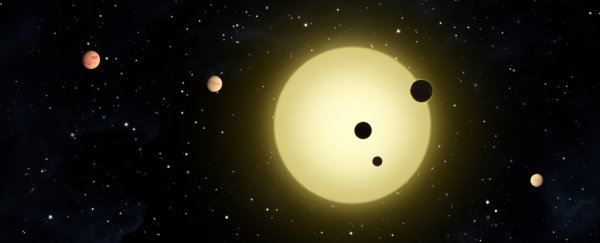Sometimes planets turn up where you least expect - such as in data from the Kepler space-hunting telescope that had already been analysed.
It's there that astronomers have found a treasure trove - 18 Earth-sized exoplanets, including one that may be habitable.
The largest is a little over twice the size of Earth. The smallest, about 69 percent of Earth's size. They're so small that previous surveys missed them, but a new technique has brought them into the light.
And it could help us find the galaxy's 'missing' Earth-sized planets.
At time of writing, planet-hunting missions around the world have confirmed the existence of 3,970 exoplanets. Most of them are huge. Around 96 percent are significantly larger than Earth; most of the exoplanets we've found fall into the gas giant category, like Neptune, or Saturn, or Jupiter, and even larger still.
But if we use our own Solar System as a baseline, there should be a lot more rocky, Earth-like planets out there. We have four - Earth, Venus, Mercury and Mars. That's half the planets in the Solar System (not even including dwarf planets like Pluto, Haumea and Ceres).
So, scientists believe there should be more rocky planets out there - but the upper size limit for a rocky planet is believed to be around twice the diameter of Earth. The search algorithms used for analysing the Kepler data just aren't sensitive enough to detect planets that small.
It all has to do with the way Kepler detects planets. It uses something called the transit method, searching for the faint dips in a star's light as a planet passes between it and us. The algorithms used to pick these out of the data generally try to detect sudden, clear dips, and that's fine for larger planets, but that's not necessarily the way it would work for smaller, rocky planets.
"In reality," explained astrophysicist René Heller of the Max Planck Institute for Solar System Research, "a stellar disk appears slightly darker at the edge than in the center. When a planet moves in front of a star, it therefore initially blocks less starlight than at the mid-time of the transit. The maximum dimming of the star occurs in the center of the transit just before the star becomes gradually brighter again."
For larger planets, the dip it produces - the light curve - is pretty obvious, even if the algorithm is searching for a sudden dip. But the transits of smaller planets are difficult to differentiate from normal fluctuations in a star's light levels, even at the best of times, the researchers said. Using an unrealistic light curve just makes it harder still.
 (NASA/SDO (Sun), MPS/René Heller)
(NASA/SDO (Sun), MPS/René Heller)
So, the team decided to see what would happen if they used an algorithm looking for a more gradual light curve. They then applied this to the 517 stars identified by the K2 Kepler mission with one or more transiting planets.
And that's where they found the 18 planets.
Most of them, unfortunately for the search for habitable worlds, were orbiting very close to their stars, and would likely have surface temperatures in excess of 100 degrees Celsius - over 1,000 degrees Celsius, in one case.
 (NASA/JPL (Neptune), NASA/NOAA/GSFC/Suomi NPP/VIIRS/Norman Kuring (Earth), MPS/René Heller)
(NASA/JPL (Neptune), NASA/NOAA/GSFC/Suomi NPP/VIIRS/Norman Kuring (Earth), MPS/René Heller)
The lone exception was EPIC 201238110.02, in orbit around a cool red dwarf. Its distance placed it within its star's habitable 'Goldilocks' zone - not too hot, and not too cold, but just right for liquid water on the surface, one of the prerequisites for life as we know it.
We've found planets like this before, of course - often orbiting red dwarf stars, which presents its own set of problems. Our detection methods work best for planets with a close orbit; and a close orbit is most likely to be habitable for red dwarfs, if not for one thing: they usually spew out a lot of flares, the radiation from which could be pretty deadly for nearby planets.
But that's not a sure thing. And the best way to find out is to find a bunch more Earth-sized planets - which is exactly what this new algorithm will help achieve.
The Kepler archive contains datasets for hundreds of thousands of stars. We can't wait to see what's orbiting them.
The research has been published in two papers in Astronomy & Astrophysics. They can be found here and here.
